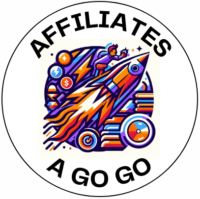
First things first. Let’s get straight to the point. What exactly is website monetization? In simple terms, it’s how you, as a website owner, turn your online presence into a long-term revenue source. It’s not just about making a few quick bucks; it’s about creating a sustainable, growth-oriented income stream that capitalizes on your website’s potential. Read on to learn How to: Website Monetization.
Monetizing your website is a critical move. It’s the difference between running a website as a hobby and turning it into a bona fide business. To generate and increase an income, maintaining your site, improving its quality, and investing in its growth, are all essential.
Now, there’s a lot of opportunity in monetization, but it can feel like navigating a maze without a reliable guide. That’s where Wealthy Affiliate comes into the picture. A community-centric platform founded by Kyle Loudon and Carson Lim, Wealthy Affiliate equips you with tools, training, and support to monetize your website effectively. From hosting services to comprehensive education on affiliate marketing, it’s a treasure trove that can help you at every stage of your monetization journey.
With this solid understanding of what monetization entails and why it’s crucial, it’s time to switch gears. Your first consideration is, “Who are you creating content for?” As we have already seen, this question is key, and the success of your monetization strategies hangs on the answer.
In the next section, we will recap on how to identify your audience, how to understand them, and ultimately, how to tailor your monetization strategies specifically to their needs.
Decoding Your Audience for Precision Monetization
The base to your secret sauce of a successful monetization strategy begins with an intimate knowledge of your audience. Imagine trying to sell ice to Eskimos or sending coals to Newcastle. Pointless, right? Identifying your target audience prevents you from heading off on such wild goose chases. It is the bedrock upon which you will build your monetization efforts.
Now, crafting a profile of your ideal website visitor isn’t just about demographics or browsing habits; it’s about getting into their heads.
- What interests them – what products or services will enhance their enjoyment of them?
- What are their pain points – what can you suggest to them that will help alleviate these pain points?
Understanding these facets will allow you to craft content and choose affiliate products that they’ll actually want to engage with.
Answering those two questions will get you a long way in affiliate marketing, but you shouldn’t just settle there. Tailoring your monetization strategies to your audience goes beyond these broad questions. Better understanding, using data-driven insights gathered from your site analytics and social media feedback, will ensure that you can address their specific needs and preferences.

Next in this strategy, I’m going to show you a range of monetization methods that work in synergy with the deep understanding of the audience you’ve just built. The more relevant the monetization method, the more likely they will interact positively with it.
Navigating the Monetization Spectrum: Methods That Matter
Once you know exactly who your audience is and what they crave or need, it’s time to explore how to transform those insights into income. Here is a range of monetization methods that you can tailor to your affiliate marketing website, each with its unique strengths. Remember, it’s not just about picking one; it’s about finding the right blend that works for your specific niche and audience.
Affiliate Marketing
First, let’s talk about affiliate marketing. Superficially, you might think that this is about placing a few links on your page. Of course, you will need those links (how do they get to the vendor?), but it’s about forging genuine connections between your audience and products they’ll actually benefit from.
You need to find affiliate programs that align with your content. Then you need to put those affiliate links where your readers are most engaged with a density that doesn’t overwhelm your audience – being selective here is crucial for your credibility.
I have found that Wealthy Affiliate is great, not only for helping me to connect with well-suited programs but also providing the tools for successful implementation.
Underpinning everything is great content. Without it, nobody visits, or at least nobody engages deeply enough to even consider clicking your affiliate links. Wealthy Affiliate can help you out with your content too.
Display Advertising
Moving on to display advertising, this is the old faithful of online revenue. It involves hosting ads from various networks like Google AdSense on your site.
It’s not quite as simple, though, as just signing up for AdSense and hoping that the revenue will flow. First and foremost, it’s important that you apply to AdSense at the right time in the lifecycle of your website to be successfully accepted onto the program. You can’t earn a penny, never mind maximize its benefits if you can’t join the program.
Here are six key points to consider before you apply:
Content Quality and Quantity: Ensure your website has a significant amount of high-quality, original content. The same rules apply as they do for ranking in their search results; Google is looking for sites that provide value to their audience. Therefore, you need well-written articles or other content. As a rule of thumb, between 20 and 30 well-crafted posts is a good starting point.
Website Age: In some jurisdictions, Google requires that your website is at least six months old. This criterion helps Google assess the consistency and quality of your content over time.
Website Traffic: While there is no minimum traffic requirement, a steady flow of visitors will almost certainly improve your chances of acceptance. It stands to reason, that sites with higher traffic are more likely to generate significant ad revenue. As discussed previously, your initial efforts in this regard should be through good SEO practice, social media, and quality content.
Compliance with AdSense Policies: Stand to reason; their platform, their rules. Make sure your website complies with the AdSense program policies and terms of service. Put briefly, this means a user-friendly design, easy navigation, and original content – no copyright infringement. In addition, not that adult material, and excessive profanity are both prohibited by Google.
User Experience: Google will love your website even more if it offers a good user experience. Aim for fast loading times, mobile responsiveness, and a clean design. Your website should be well-organized, professional-looking, and accessible across all devices.
Privacy Policy, About Us, and Contact Us Pages: These pages make your site look more professional and trustworthy to both users and Google. Having them significantly increases your chances of being accepted into the program.

Google may well reject you the first time you apply. If AdSense is a way that you have identified as part of your strategy, don’t panic. They will provide reasons for the rejection. You can then make the necessary adjustments and reapply.
Once you are approved, take care to place ads strategically. Ensure that they complement your content rather than cluttering it.
Selling your Own Products
You may plan to create a course, write an eBook, or design unique merchandise. Selling products, be they digital or physical opens a new revenue stream and enables you to deliver value in yet another way. Now, your website is a storefront and not just a marketing tool.
Sponsored Content
Sponsored content is a form of advertising integrating commercial content into the natural flow of your website. The idea is that it is more engaging and less intrusive than traditional advertisements by matching the look and feel of your website. It should:
Enhance your Users’ Experience: Sponsored content should seamlessly blend with your site’s editorial content, providing a more cohesive and less disruptive user experience than standard ads. Furthermore, by aligning sponsored content with the interests and preferences of your audience, you can offer value, ensuring that even sponsored posts are informative, entertaining, or useful; therefore, they are more likely to bring you monetary value. It will:
Fit with your Monetization Strategy: Sponsored content is a direct monetization strategy where you are paid by businesses to feature their content on your website. If your site has an audience that is valuable to advertisers, this can be a lucrative revenue stream. It can also help to diversify your website’s income, complementing your other revenue streams.
Building Relationships with Brands: By collaborating with brands on sponsored content, you can build long-term partnerships. These will provide a steady income stream and help you develop opportunities for other collaborative efforts. In addition, working with brands that align with your site values and audience interests can greatly enhance your site’s credibility.
Content Variety: Sponsored content can offer a fresh perspective; a fresh pair of eyes may see new opportunities. New viewpoints and information will enrich your site’s content offering. Also, sponsored content can allow you to allocate resources to other areas of your site and even facilitate funding for content creation.
Because one of the features of sponsored content is its seamless integration with your other content, it should be clearly labelled as such to help maintain trust with your audience. Using tags like “Sponsored” or “Ad” will distinguish it from non-sponsored content.

Sponsored content should meet your website’s quality standards and provide value to your audience. Further, on this point, you should make sure that sponsors and content align with your audience’s interests and needs. It would be foolish to have a website about dogs yet include sponsored material about motorcycle gear.
Lastly, on this point, you must adhere to legal requirements and guidelines, such as those set forth by the Federal Trade Commission (FTC) in the United States, regarding disclosure and transparency.
Monitoring the performance of your monetization methods is important as it enables you to adapt your approach based on real data. In so doing, you can continually optimize for better results, and ultimately, increase your earnings without compromising the user experience.
Enhancing Monetization through Data-Driven Strategies
You’ve implemented several monetization methods on your affiliate marketing website. Next comes a crucial part: analysing and optimising for better results. It’s not just about setting things up and hoping for the best; it’s about making informed decisions based on data.
Monitoring your site’s performance is not as much like witchcraft as it might sound. Tools like Google Analytics can become your best friend. It will furnish you with information on metrics such as click-through rates (CTRs), conversion rates, and the average time visitors spend on your pages. This information will tell you a lot about user behaviour and interest.
I strongly urge you to consider the use of A/B testing, also known as split testing. This involves comparing two versions of a webpage to see which one performs better. You might test different placements of your affiliate links or variations in ad design. It is quite literally all about finding what clicks with your audience.
It is also true that optimization isn’t something that you do once and forget about. It’s a constant of your business. Sometimes, it’s those small tweaks that lead to significantly higher conversion rates. Changing the colour of a ‘Buy Now’ button or slightly revising call-to-action phrases might have a big impact.
Always, your end goal is to provide a seamless user experience that builds trust and value and ultimately encourages those clicks. An optimized monetization strategy goes a long way towards prioritising your audience’s needs. People always appreciate their needs being prioritized.
Our final section is about scaling your monetization efforts. If you can earn $10 you can earn $100 and so forth.
Capturing the Financial Future: Leading Your Revenue to Victory
Congratulations, you’ve become an adept navigator on the shifting seas of website monetization. In this closing section, not only will we have a recap of the essence of what’s been discussed but we will also peek into the future of your affiliate marketing website’s potential.
Remember, although monetization is ultimately about making money; it’s also about value exchange. In providing great value to your audience, the quid pro quo is a monetary return on your efforts. Your monetization strategies reward your content creation efforts. The beauty of this dynamic is that it encourages a cycle of ongoing experimentation and adaptation. Stay curious, stay creative, and the path to financial fruition will keep unfolding before you. The point is that earning $10 leads to earning $100 which leads to $1000.
Measurement is key. You can’t improve something that’s not working if you don’t know it’s not working. Constant evaluation, reassessment, and the pursuit of ‘what works best’ should be your mantra. Tweak your strategies based on performance data, audience feedback, and industry trends – and keep on the lookout for new opportunities in monetization that align with your content and values.

Underpinning everything is the trust of your audience. This is not a new thing peculiar to the online world. It’s been a central tenet of business since time immemorial. Keep providing content that educates, entertains, and enlightens, and your monetization efforts will naturally align with those goals. It’s a virtuous cycle that the Wealthy Affiliate membership can help foster, sustain, and grow.
In conclusion, these principles, when applied diligently will ensure that your affiliate marketing website thrives. Your strategic action and consistent optimization, supported by a wealth of resources and community support from Wealthy Affiliate will transform it into a source of sustainable income.
